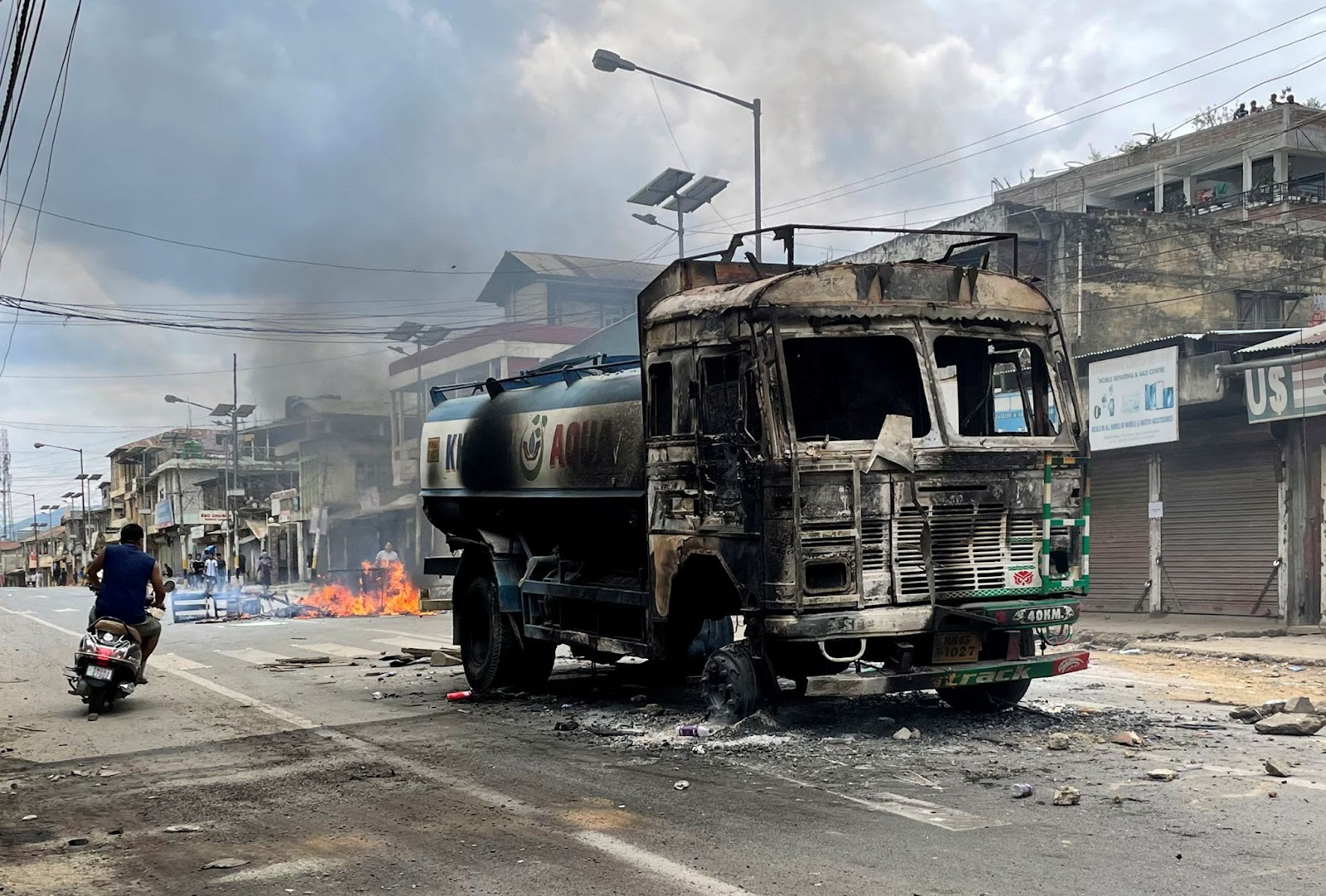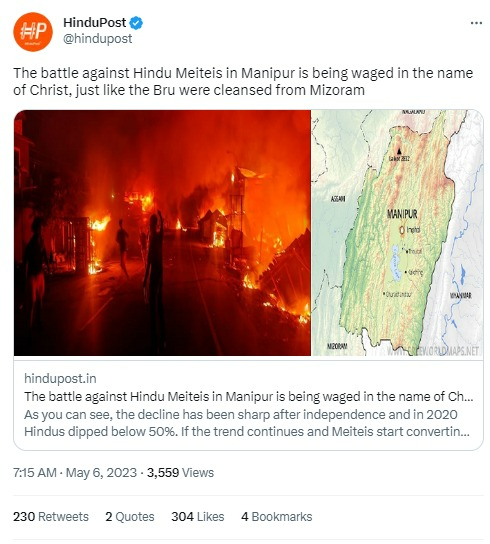By: Chandan Borgohain , Anurag Baruah
May 11 2023
 Source: Twitter/@MangteC
Source: Twitter/@MangteC
The Indian state of Manipur has witnessed a wave of violent ethnic clashes since May 3, with the state government reportedly stating that at least 60 people have died so far, 1,700 religious places and houses burnt, and 231 injured. According to reports, over 16,000 people have been forced to take shelter in military compounds.
Calling the crisis a “humanitarian problem,” the Supreme Court of India stressed the need to protect people and property. As tension deescalates in the state, with no new reports of violent incidents since May 7, state curfew has been relaxed in 11 districts. However, mobile internet and broadband internet services remain suspended.

A damaged water tanker set on fire in Churachandpur, Manipur. Source: REUTERS/Stringer
While the immediate violence broke out after a solidarity march by the All Tribal Students' Union Manipur (ATSUM) to oppose the demand for inclusion of the majority Meitei community in the Scheduled Tribe (ST) category, the tension has been simmering for years.
But many online users claim this clash between the Kuki community and Meitieis, who are Christians and Hindus respectively, was an incident of communal violence. A few even say it's happening because of the "illegal immigrants from Myanmar." These parallel narratives are rife on social media, but how much of it is true? We spoke to experts and looked at history to find answers.
Over the last week, several posts on social media are blaming either Hindus or Christians as perpetrators of the violence, and others say 'illegal immigrants' from Myanmar are attacking the 'indigenous Meiteis.'

Screenshots of posts alleging religion-based violence being perpetrated against Hindu Meities
Hashtags such as #savemanipurfrom_illegal_immigrants_kuki, #SaveMeiteiHindus, #meiteigenocide were trending on Twitter and other social media platforms.
Sample this, a tweet (see archived version here) with the caption, “Save Hindus in Manipur” shares an edited video compiling a series of unverified and misleading clips. The text overlaid the video claims that the “Hindu Meiteis” in Manipur were subjected to “genocide” by Christian Kukis.
The Frontier Manipur Editor Dhiren A. Sadokpam points out in an article on Frontline that there is a "feeling of being persecuted" among the Kuki community. He argues that the government's tough stance against several Chin – people of the same ethnic group from Myanmar – has angered the Kukis.
The second major reason he points out is "pressure on land" in Manipur. He writes, "As populations increase in the tribal villages, they tend to spread out into surrounding forest areas, which they consider their historical and ancestral rights. This is contested by the government" adding that the Meitei community is angry because they are not allowed to settle or buy land in the hill areas, while tribals can buy land in the valley.
The plains or the central valley, which accounts for about 10 percent of Manipur's landmass, is primarily inhabited by the Meiteis. While the remaining 90 percent of the state's geographical area, comprising the hills, is home to the tribals. Journalist Patricia Mukim noted that the origins of the current unrest can be traced to the state government's attempts to survey the forest in the hills on the plea of bringing them under "reserved forests."
On April 28, a mob vandalized and set on fire the venue where the chief minister of Manipur was scheduled to attend a programme in Churachandpur district. The ATSUM said the violent outburst resulted from growing dissent against the "adverse and regressive policies" of the current government of Manipur. In February, a village in Churachandpur district was evicted as part of the "government's initiative to protect and preserve protected/reserve forests." Tribal bodies called the eviction drive a "violation of human rights".
But Singh's government alleges the forest lands are being used by "encroachers" for "poppy plantation and drugs business."
However, ignoring these facts and making an already bad situation worse, unverified posts are shared by users with hundreds of thousands of followers on social media. For example: a Twitter account that goes by the name of Hindu Post and has over 38,000 followers claimed that "the battle against Hindu Meiteis" in Manipur is waged "in the name of Christ."

Screenshot a Hindu Post article alleging “battle against Hindu Meiteis”
Another one went on to claim that many Meitei women have been raped by Kukis in Churachandpur. When in fact no such incident has been reported. Manipur Director General of Police P Doungel clarified that no rape cases are reported in Churachandpur.

Screenshot of a post falsely alleging Meitei women were sexually assaulted got nearly 80,000 views
Speaking to Logically Facts, northeast-based journalist Rajeev Bhattacharyya said, "This is not the first time that such posts have surfaced on social media and nor will it be the last. It has become a very convenient tool for propaganda."
Narratives alleging the conflict is not an ethnic, but a religious one aren't new, considering Meiteis and Kukis have had deep-rooted issues, even resulting in clashes in 2015.
Rallying Bhattacharyya's point, journalist and editor of Imphal Review of Arts and Politics Pradip Phanjoubam, too, said, "To say this is a religious issue just because the opposing groups are predominantly Hindus and Christians is completely false and baseless. This has got nothing to do with religion."
From the 52,000 refugees who have crossed Indo-Myanmar border into the northeast, 7,800 are in Manipur, according to indigenous scholar Binalakshmi Nepram. Illegal immigrants from Myanmar in the state have historically been a contentious issue.
Simmering tensions were used to weave narratives pinning the blame on the "illegal immigrants." "While some form of illegal immigration is there amongst Kukis, it cannot be said that they are behind the recent clashes with the Meiteis. This is more of an internal issue," Phanjoubam told Logically Facts.
Phanjoubam, in an article for The Indian Express, says that this narrative is at best a "half-truth" and often used to "humiliate the Kukis as refugees." He argues that it's not just the "social media trolls" but even the government authorities using such insinuations to humiliate Kukis.
"The sensitivity has come to be such that even normal policies such as eviction from reserved forests, or the fight against poppy plantations, have come to be seen as targeting Kukis, adding to their hurt," he writes.
The Kukis are part of the Zo group of tribes, a transborder community that inhabits areas of India, Myanmar and Bangladesh. Called Chin in Myanmar, thousands of refugees from the neighbouring county have fled across the border to the northeastern states of Mizoram and Manipur after the 2021 coup.
A Manipur based media outlet called ISTV, reportedly branded the protesters as "illegal immigrants" in one of its news bulletins on April 28. Kuki Liberation Army-Letkholun (KLA-L) condemned ISTV over this and demanded an apology from the channel for spreading "false narratives" against the protesters.